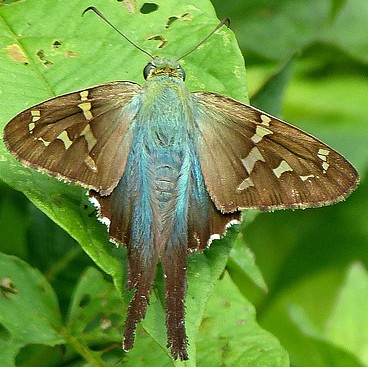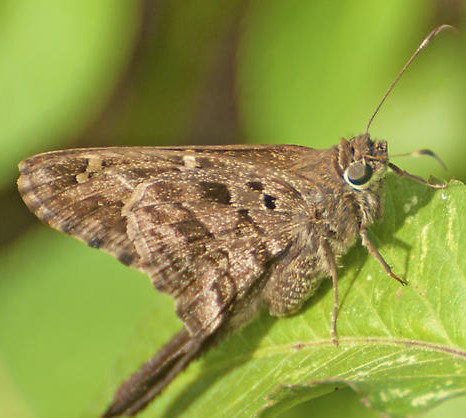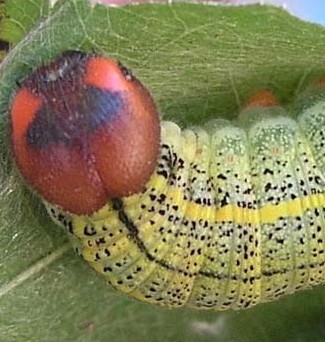 Primarily a butterfly of South and Central America, the long tailed skipper can be found in Texas, Southern California, Arizona, Texas, Florida, and occasionally in the Mississippi Valley, Midwest, and East Coast to Connecticut. It prefers disturbed habitats including gardens, roadsides, abandon fields, woodland edges, and coastal dunes. The long-tailed skipper is an erratic flyer with a wing span up to two inches across, long tails projecting 1/2″, and a unique green iridescence on the upper side of the wings and body. The wings are otherwise brown with white markings.
Primarily a butterfly of South and Central America, the long tailed skipper can be found in Texas, Southern California, Arizona, Texas, Florida, and occasionally in the Mississippi Valley, Midwest, and East Coast to Connecticut. It prefers disturbed habitats including gardens, roadsides, abandon fields, woodland edges, and coastal dunes. The long-tailed skipper is an erratic flyer with a wing span up to two inches across, long tails projecting 1/2″, and a unique green iridescence on the upper side of the wings and body. The wings are otherwise brown with white markings.
 Males are territorial and find females in sunny openings. After a ritual dance and mating the females lay their eggs under leaves of host plants. The eggs are laid singly or in clusters of two to six and are white at first but turn pale yellow. The caterpillars that appear in three of four days are up to 1.25″ long, and are yellow-green with yellow lateral lines, black speckling, and a reddish brown head with a black face. They roll themselves in a leaf and emerge at night to feed. Eventually they form a chrysalis that is cocoa brown with hints of blue and yellow, and has a powdery white coating. The life cycle is completed in about thirty days so three or more broods are possible in the southern part of its US range.
Males are territorial and find females in sunny openings. After a ritual dance and mating the females lay their eggs under leaves of host plants. The eggs are laid singly or in clusters of two to six and are white at first but turn pale yellow. The caterpillars that appear in three of four days are up to 1.25″ long, and are yellow-green with yellow lateral lines, black speckling, and a reddish brown head with a black face. They roll themselves in a leaf and emerge at night to feed. Eventually they form a chrysalis that is cocoa brown with hints of blue and yellow, and has a powdery white coating. The life cycle is completed in about thirty days so three or more broods are possible in the southern part of its US range.
 The caterpillars feed on legumes especially beans such as snap beans, cowpeas, lima beans, and peas so in areas where these plants are grown as cash crops the long-tailed skipper is considered a pest and measures taken to eliminate it. Wisteria (Wisteria sinensis) can be used to accomadate caterpillars in the garden but beggar weed (Desmodium incanum), hog peanut (Amphicarpa bracteata), and kudzu (Pueraria lobata) growing wild in the area will also meet their needs. Adults seek nectar from a variety of plants including lantana (Lantana camara), Bougainvillea, purpletop vervain (Verbena bonariensis), Mexican sunflower (Tithonia rotundiflora), Mexican heather (Cuphea hyssopifolia), Eupatorium species, and the wildflower, , shepherd’s needle (Bidens alba).
The caterpillars feed on legumes especially beans such as snap beans, cowpeas, lima beans, and peas so in areas where these plants are grown as cash crops the long-tailed skipper is considered a pest and measures taken to eliminate it. Wisteria (Wisteria sinensis) can be used to accomadate caterpillars in the garden but beggar weed (Desmodium incanum), hog peanut (Amphicarpa bracteata), and kudzu (Pueraria lobata) growing wild in the area will also meet their needs. Adults seek nectar from a variety of plants including lantana (Lantana camara), Bougainvillea, purpletop vervain (Verbena bonariensis), Mexican sunflower (Tithonia rotundiflora), Mexican heather (Cuphea hyssopifolia), Eupatorium species, and the wildflower, , shepherd’s needle (Bidens alba).